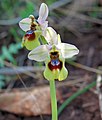Wasp ragwort
| Wasp ragwort | ||||||||||||
|---|---|---|---|---|---|---|---|---|---|---|---|---|

Wasp ragwort ( Ophrys tenthredinifera ) |
||||||||||||
| Systematics | ||||||||||||
|
||||||||||||
| Scientific name | ||||||||||||
| Ophrys tenthredinifera | ||||||||||||
| Willd. |
The wasp-orchid ( Ophrys tenthredinifera ) is a kind of genre of Ragwurzen in the family of orchids (Orchidaceae). In the generic name, the name consists of the ancient Greek word ὀφρύς ( ophrys ) = "eyebrow" and in the type epithet from the ancient Greek-Latin word tenthredinifer = "leaf wasp-bearing". The first description of this species was made in 1805 by the botanist Carl Ludwig Willdenow in the work " Linnaei Species Plantarum ". Due to the variability of the flowers, this species has so far been described over thirty new times or as a subspecies or as a variety, with names that are mostly considered synonyms .
description
The wasp ragwort is a perennial herbaceous plant . It has two egg-shaped-spherical tubers as persistence organs and reaches stature heights of 10 to 30 cm, sometimes up to 45 cm. There are two scale leaves at the base of the stem . Three to six elongated, lanceolate leaves between 4 and 12 cm in length are grouped together in a base rosette. One to four sheathed bracts are found on the lower half of the stem. The bracts are elongated and longer than the ovary.
The loose inflorescence is up to 12 cm long and has one to ten flowers . The broadly ovate to elliptical sepals are mostly pink, rarely white. The thickly hairy lip is 11-16 mm long, undivided, somewhat arched and slightly tubercular. The shape varies from oval to rectangular or trapezoidal. There is a small upright appendage in front. The center of the lip is dark red-brown, the wide margin is yellowish in color. The small mark at the bottom of the lip is gray-purple to bluish with a whitish edge and covers the orange-brown basal field like a lump.
The flowering time in North Africa is from February to March, while in the rest of the Mediterranean area it extends from mid-March to May.
The number of chromosomes is 2n = 36, 38 or 54.
Location and distribution
This orchid prefers garrigues , grasslands, sparse pine forests and maquis with basic to slightly acidic soils up to an altitude of 1800 m .
The distribution area extends almost over the entire Mediterranean area and is only missing on the Levant and Cyprus . In the east the distribution area ends in southern Turkey .
Variations
In Portugal , an early flowering variant with one to four flowers is described.
ecology
Eucera nigrilabris , Eucera bidentata (Ionian Islands), Eucera dimidiata (Crete) and Eucera kullenbergii (Western Turkey) were observed as pollinators .
Picture gallery
- Color variants and Ophrys tenthredinifera ssp. spectabilis
Ophrys tenthredinifera
Italy - Sicily
Zingaro
literature
- Helmut Baumann , Siegfried Künkele : The wild growing orchids of Europe . Franckh, 1982, ISBN 3-440-05068-8
- Karl-Peter Buttler : Orchids, the wild growing species of Europe . Mosaik Verlag 1986, ISBN 3-570-04403-3
- Hans Sundermann : European and Mediterranean orchids . Brücke-Verlag, 2nd edition: 1975, ISBN 3-87105-010-5
- JG Williams: Orchids of Europe with North Africa and Asia Minor . BLV Verlag, ISBN 3-405-11901-4
- Ralf Jahn, Peter Schönfelder: Excursion flora for Crete . With contributions by Alfred Mayer and Martin Scheuerer. Eugen Ulmer, Stuttgart (Hohenheim) 1995, ISBN 3-8001-3478-0 , p. 431 .
Individual evidence
- ^ Ophrys tenthredinifera at Tropicos.org. In: IPCN Chromosome Reports . Missouri Botanical Garden, St. Louis
- ↑ a b Helmut Baumann , Siegfried Künkele and Richard Lorenz: Orchids of Europe with adjacent areas . Verlag Eugen Ulmer, Stuttgart, 2006. ISBN 978-3-8001-4162-3 . Page 200.







